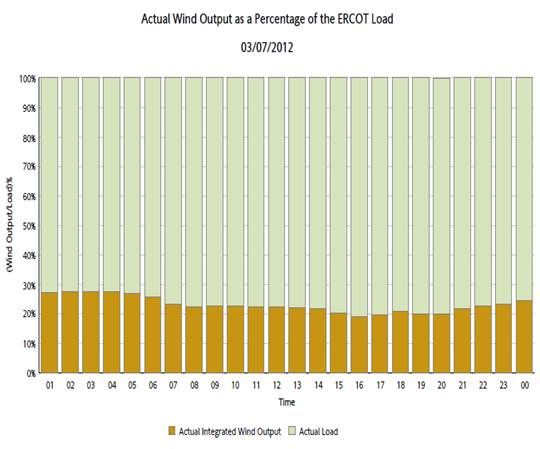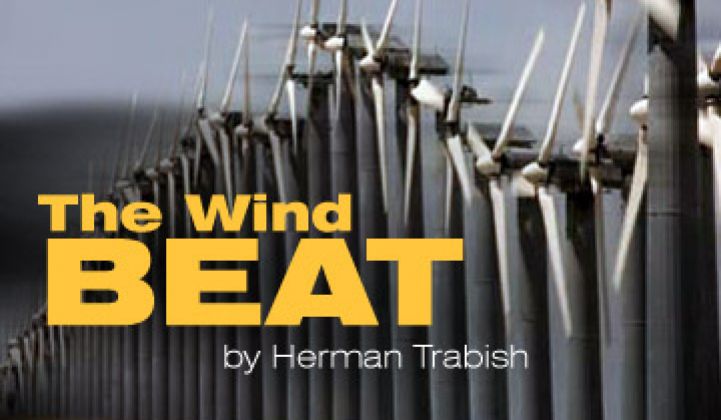Texas grid operator ERCOT hit a renewables milestone when on March 7 it used its new grid management tool to integrate over 7,500 megawatts of wind-generated electricity into the state’s power supply.
At 8:41 p.m., the Electric Reliability Council of Texas (ERCOT) was using 7,599 megawatts of wind power (22 percent of load). This surpassed the 7,403-megawatt mark (24 percent) which, at 6:55 a.m. on the previous day had surpassed the 7,400 megawatt record (fifteen percent of load) set at 3:06 p.m. on October 7, 2011.
The 7,599-megawatt mark represented over 77 percent of the state’s U.S.-leading 9,838 megawatts of nameplate wind capacity, far exceeding wind’s average 30 percent to 40 percent capacity factor.
“March is typically a high wind month for ERCOT, but these new records are also due in part to a new transmission analysis tool we started using this week,” said ERCOT Grid Operations/System Planning Director Kent Saathoff.
The new Transient Security Assessment Tool (TSAT) was designed to help manage the variability of renewables, particularly wind. It “improves the accuracy of our transmission limits,” Saathoff explained, by incorporating knowledge of “the most current conditions available” into ERCOT’s assessments as wind power and demand fluctuate.
“The new tool runs an analysis on real-time conditions every 30 minutes,” Saathoff said. Before instituting use of the tool, ERCOT had to rely on less variable sources because its ability to assess load had to be planned further in advance.

“This new tool is the next step" in renewables integration, American Wind Energy Association (AWEA) Transmission Policy Manager Michael Goggin said. It allows grid operators to know “the amount of power that can be safely and reliably be moved across transmission lines.”
ERCOT’s 9,838-megawatt capacity is widely dispersed around the state. It has 7,531 megawatts in famously windy West Texas, 232 megawatts in the northern panhandle, and 2,075 megawatts along the Gulf Coast.
With its new sub-hourly analysis, ERCOT can draw on this large geographic dispersion of balancing areas to use wind-generated power wherever the wind is blowing. Some 13 percent of the record-setting 7,599 megawatts came from newer wind installations on the Gulf Coast where the wind availability pattern typically differs from and complements wind availability in West Texas and the Panhandle.
The new tool allows ERCOT to “move more wind energy from the west zone,” Saarthoff said.
By 2009, ERCOT spokeswoman Dottie Roark further explained, wind’s expansion in Texas had begun “to overwhelm the existing transmission capacity available to move the power from remote areas of West Texas to large cities, such as Dallas and San Antonio, that consume the power.” To manage the growing transmission congestion, she said, “operators sometimes have to instruct wind generators to reduce their output as necessary to maintain transmission equipment within rated limits.” The new tool minimizes that constraint.
The Western Wind and Solar Integration Study (WWSIS), from the National Renewable Energy Laboratory, showed that over a third of U.S. electricity could come from renewables using the nation’s present transmission system if grid operators adopted tools like the one ERCOT has initiated.
Such tools should, the WWSIS said, “substantially balancing area cooperation or consolidation, real or virtual”; “increase the use of intra-hour scheduling of generation and interchanges”; “increase utilization of transmission”; and "enable coordinated commitment and economic dispatch of generation over wider regions.”
ERCOT added most of those capabilities in February 2011 through a nodal market design that improved its wind data collection and forecasting and added several dimensions of flexibility to its resource management.

ERCOT is also in the process of matching rapid Texas wind expansion with rapid transmission expansion through its groundbreaking $6.87 billion Competitive Renewable Energy Zones (CREZ) program. The Public Utilities Commission of Texas (PUCT) foresees the availability of 18,456 megawatts of wind power for Texas ratepayers by the end of next year.
Texas' record-setting performance “joins a number of other major wind accomplishments in the U.S. over the last few months,” AWEA’s Goggin noted, including when Xcel Energy Colorado obtained over 55 percent of its electricity from wind for a period last October, when the Midwest ISO used a record 8,522 megawatts of wind-generated electricity on January 1, 2012, and when the plains states’ Southwest Power Pool used a record 3,927 megawatts on December 31, 2011.
The secret of how to get more renewables onto the grid appears to be getting out.



